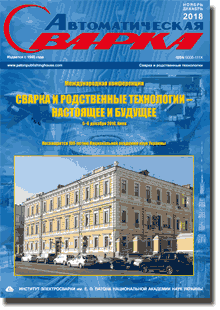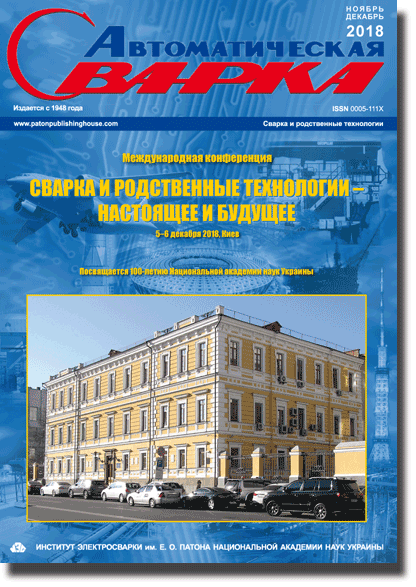| 2018 №12 (04) |
DOI of Article 10.15407/as2018.12.05 |
2018 №12 (06) |

«Автоматичне зварювання», № 11-12, 2018, с. 58-68
Зниження рівня бездеформаційних зварювальних напружень термічним натягом
Гуан Цяо
Китайська інженерна академія, Пекінський науково-дослідний інститут технології виробництва авіатехніки (BAMTRI). а/с 863, 100024, Пекін, Китай. E-mail: guanq@cal.cn
При виготовленні листових пластин, панелей і оболонок за допомогою зварювання деформації поздовжнього вигину стають істотними, особливо для аерокосмічних конструкцій з товщиною металу менше 4 мм. Для запобігання втрати стійкості розроблено методи зварювання з низькою напругою без деформацій. Ці інноваційні методи успішно застосовуються у виробництві аерокосмічних конструкційних компонентів. У статті докладно описано та узагальнено особливості методів зварювання з низькою напругою без деформацій з використанням або повного ефекту термічного натягу поперечного перерізу, або ефекту локального теплового натягу. Основна ідея цих методів зварювання полягає в тому, щоб виконувати активне управління процесом характерних пластичних (несумісних) деформацій та напружень при зварюванні для отримання результатів без деформацій, щоб не було потрібно дорогих операцій з повторної обробки після зварювання для корекції геометрії виробів. Особлива увага приділяється аналізу за методом кінцевих елементів для прогнозування і оптимізації локалізованого теплового натягу з теплоотводом, пов’язаним з джерелом зварювального тепла. Рекомендується вибирати параметри для інженерного рішення. Бібліогр. 21, табл. 1, рис. 15.
Ключові слова: залишкова напруга зварювання, низька напруга бездеформаційного зварювання, бухтиноватість, термічний натяг, температурні розтягування, метод кінцевих елементів
Надійшла до редакції 15.05.2018
Підписано до друку 06.11.2018
Література
- Terai, K. (1978) Study on prevention of welding deformation in thin-skin plate structures. Kawasaki Technical Review. (61): 61-66.
- Masubuchi, K. (1980) Analysis of welded structures. Oxford, Pergamon Press.
- Guan, Q. (1999) A survey of development in welding stress and distortion control in aerospace manufacturing engineering in China, Welding in the World, 43(1): 14-24.
- Guan, Q., Guo, D. L. et al. (1987) Method and apparatus for low stress no-distortion welding of thin-walled structural elements. Original Chinese patent 87100959.5. 1988.International patent specification No PCT/GB88/00136.
- Guan, Q., Zhang, C. X. et al. (1993) Dynamically controlled low stress no-distortion welding method and its facility. Chinese patent 93101690.8.
- Zhong, X. M., Murakawa, H. and Ueda, Y. (1995) Buckling behavior of plates under idealized inherent strain. Transactions of JWRI. 24(2): 87-91.
- Michaleris, P. et al. (1999) Minimization of welding residual stress and distortion in large structures. Welding Journal. 78(11): 361-s to 366-s.
- Deo, M. V., Michaleris, P. (2003) Mitigating of welding induced buckling distortion using transient thermal tensioning. Science and Technology of Welding and Joining. 8(1): 49-54.
- Tsai, C. L. et al. (1999) Welding distortion of a thin-plate panel structure . Welding Journal. 78(5): 156-s to 165-s.
- Paton, B. E. et al. (1989) Fabrication of thin-walled welded large panels of high strength aluminum alloys. Svarka. (10) (in Russian).
- Radaj, D. (1992) Heat effects of welding: temperature field, residual stress, distortion. Berlin, Springer-Verlag.
- Guan, Q. et al. (1990) Low stress no-distortion (LSND) welding — a new technique for thin materials. Transactions of Chinese Welding Society. 11(4): 231-237 (in Chinese).
- Burak, Ya. I. et al. (1977) Controlling the longitudenal plastic shrinkage of metal during welding. Svarka (3): 27-29.
- Burak, Ya. I. et al. (1979) Selection of the optimum for preheating plates before welding. Svarka (5): 5-9.
- Mechaleris, P. et al. (1995) Analysis and optimization of weakly coupled thermo-elasto-plastic systems with application to weldment design, J. for Numerical Methods in Engineering. 38:1259-1285.
- Yang, Y. P., Dong, P., Zhang, J. and Tian, X. T. (2000) A hot-cracking mitigation technique for welding high-strength aluminum alloy. Welding Journal. 79(1): 9-s to 17-s.
- Dong, P. et al. (1998) Analysis of residual stresses in Al-Li repair welds and mitigation techniques. Welding Journal. 77(11): 439-s to 445-s.
- Guan, Q. et al. (1996) Low stress no-distortion welding for aerospace shell structures. China Welding. 5(1): 1-9.
- Guan, Q., Zhang, C. X. et al. (1994) Dynamic control of welding distortion by moving spot heat sink. Welding in the World, 33(4): 308-313.
- Li, J., Guan, Q., Shi, Y. W. et al. (2004) Studies on characteristics of temperature field during GTAW with a trailing heat sink for titanium sheet. Journal of Materials Processing Technology. 147(3): 328-335.
- Li, J., Guan, Q., Shi, Y. W. and Guo, D. L. (2004) Stress and Distortion mitigation technique for welding titanium alloy thin sheet. Science and Technology of Welding and Joining, 9, 5, 451-458.
Вартість передплати/замовлення на журнали або окремі статті
| журнал/валюта | річний комплект друкований |
1 прим. друкований |
1 прим. електронний |
одна стаття (pdf) |
| AS/UAH | 1800 грн. | 300 грн. | 300 грн. | 150 грн. |
| AS/USD | 192 $ | 32 $ | 26 $ | 13 $ |
| AS/EUR | 180 € | 30 € | 25 € | 12 € |
| TPWJ/UAH | 7200 грн. | 600 грн. | 600 грн. | 280 грн. |
| TPWJ/USD | 384 $ | 32 $ | 26 $ | 13 $ |
| TPWJ/EUR | 348 € | 29 € | 24 € | 12 € |
| SEM/UAH | 1200 грн. | 300 грн. | 300 грн. | 150 грн. |
| SEM/USD | 128 $ | 32 $ | 26 $ | 13 $ |
| SEM/EUR | 120 € | 30 € | 25 € | 12 € |
| TDNK/UAH | 1200 грн. | 300 грн. | 300 грн. | 150 грн. |
| TDNK/USD | 128 $ | 32 $ | 26 $ | 13 $ |
| TDNK/EUR | 120 € | 30 € | 25 € | 12 € |
AS = «Автоматичне зварювання» - 6 накладів на рік;
TPWJ = «PATON WELDING JOURNAL» - 12 накладів на рік;
SEM = «Сучасна електрометалургія» - 4 наклада на рік;
TDNK = «Технічна діагностика та неруйнівний контроль» - 4 наклада на рік.





